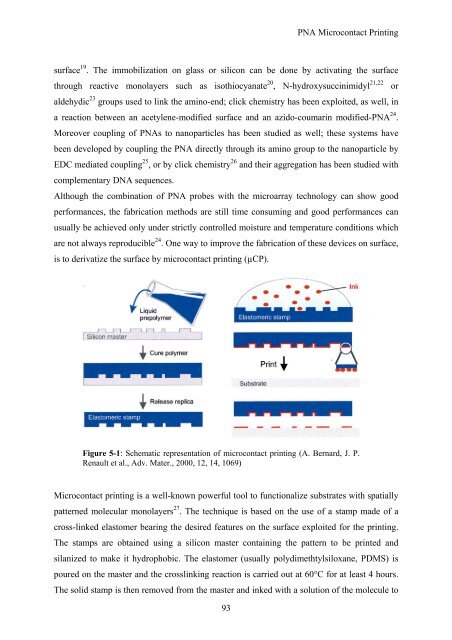View - DSpace UniPR
View - DSpace UniPR
View - DSpace UniPR
You also want an ePaper? Increase the reach of your titles
YUMPU automatically turns print PDFs into web optimized ePapers that Google loves.
PNA Microcontact Printing<br />
surface 19 . The immobilization on glass or silicon can be done by activating the surface<br />
through reactive monolayers such as isothiocyanate 20 , N-hydroxysuccinimidyl 21,22 or<br />
aldehydic 23 groups used to link the amino-end; click chemistry has been exploited, as well, in<br />
a reaction between an acetylene-modified surface and an azido-coumarin modified-PNA 24 .<br />
Moreover coupling of PNAs to nanoparticles has been studied as well; these systems have<br />
been developed by coupling the PNA directly through its amino group to the nanoparticle by<br />
EDC mediated coupling 25 , or by click chemistry 26 and their aggregation has been studied with<br />
complementary DNA sequences.<br />
Although the combination of PNA probes with the microarray technology can show good<br />
performances, the fabrication methods are still time consuming and good performances can<br />
usually be achieved only under strictly controlled moisture and temperature conditions which<br />
are not always reproducible 24 . One way to improve the fabrication of these devices on surface,<br />
is to derivatize the surface by microcontact printing (µCP).<br />
Figure 5-1: Schematic representation of microcontact printing (A. Bernard, J. P.<br />
Renault et al., Adv. Mater., 2000, 12, 14, 1069)<br />
Microcontact printing is a well-known powerful tool to functionalize substrates with spatially<br />
patterned molecular monolayers 27 . The technique is based on the use of a stamp made of a<br />
cross-linked elastomer bearing the desired features on the surface exploited for the printing.<br />
The stamps are obtained using a silicon master containing the pattern to be printed and<br />
silanized to make it hydrophobic. The elastomer (usually polydimethtylsiloxane, PDMS) is<br />
poured on the master and the crosslinking reaction is carried out at 60°C for at least 4 hours.<br />
The solid stamp is then removed from the master and inked with a solution of the molecule to<br />
93
















